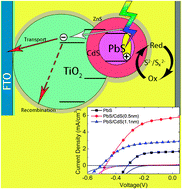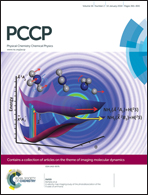Sensitized solar cells with colloidal PbS–CdS core–shell quantum dots†
Abstract
We report on the fabrication of PbS–CdS (core–shell) quantum dot (QD)-sensitized solar cells by direct adsorption of core–shell QDs on mesoporous TiO2 followed by 3-mercaptopropionic acid ligand exchange. PbS–CdS QD-sensitized solar cells show 4 times higher efficiency with respect to solar cells sensitized with PbS QDs. The significantly enhanced mean electron lifetime and electron diffusion length provide crucial evidence for the higher efficiency of the cell. The average electron lifetime increases with the thickness of the CdS shell, demonstrating that the CdS shell plays an important role in preventing carrier recombination. However, owing to the barrier provided by the offset between the conduction bands of CdS and the PbS core, the CdS shell also hinders carrier injection from PbS to TiO2. Herein, we studied the effect of the shell thickness on cell's performance, showing a power conversion efficiency of 1.28% for PbS QDs with a 0.5 nm CdS shell. In addition, we demonstrate that the CdS shell effectively prevents photo-corrosion of PbS, resulting in devices with highly stable photocurrent.


 Please wait while we load your content...
Please wait while we load your content...